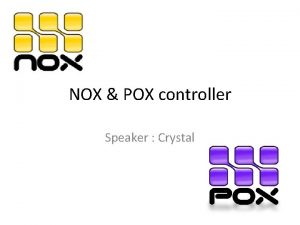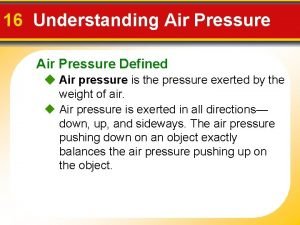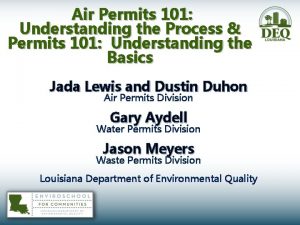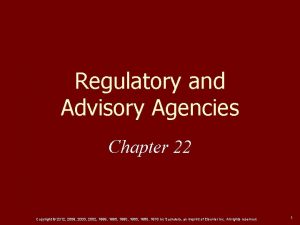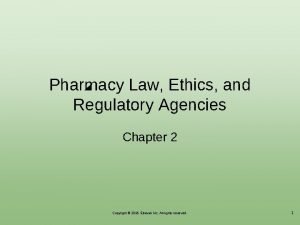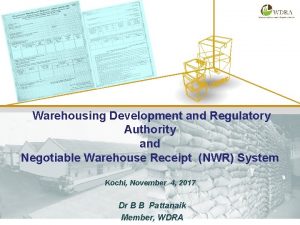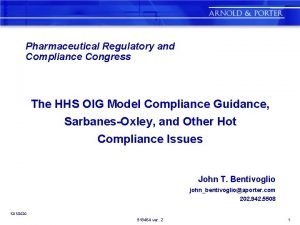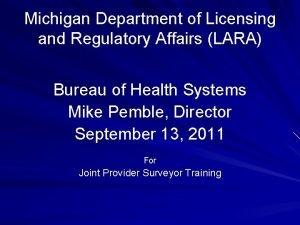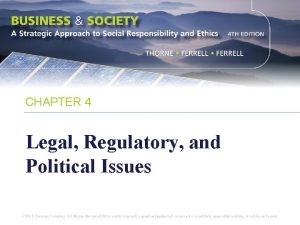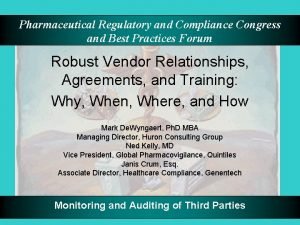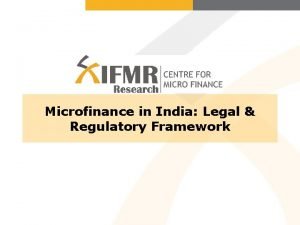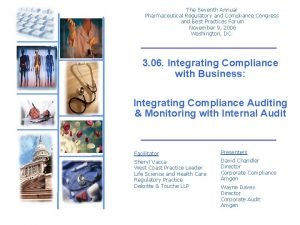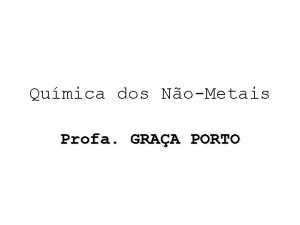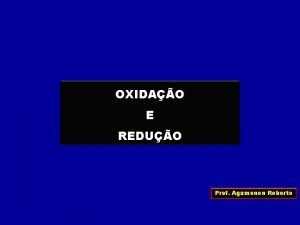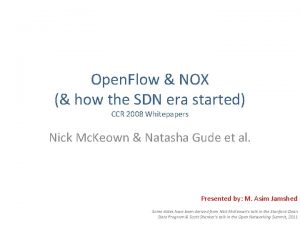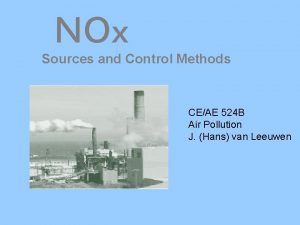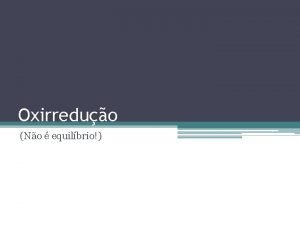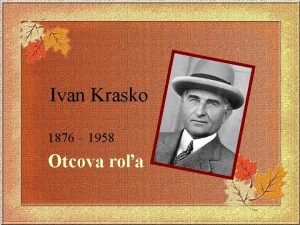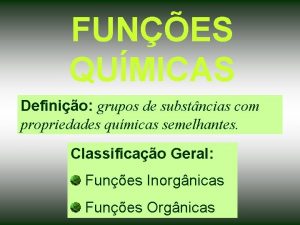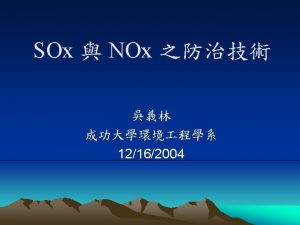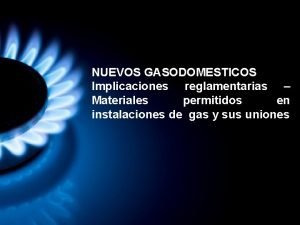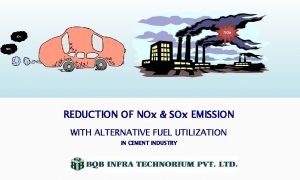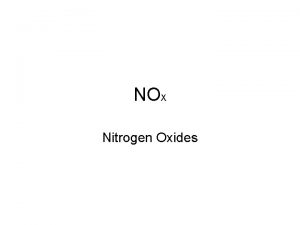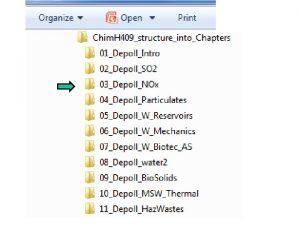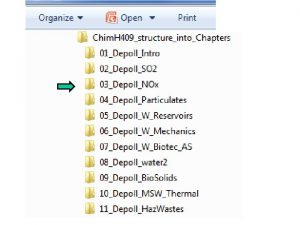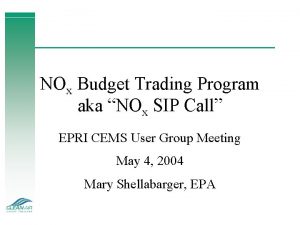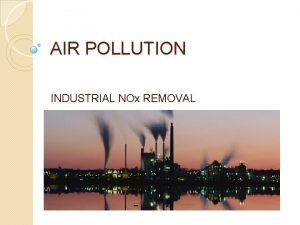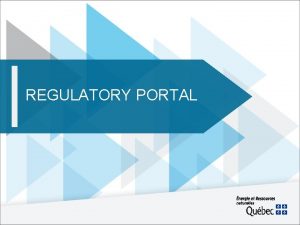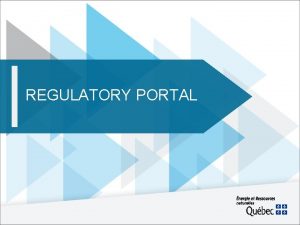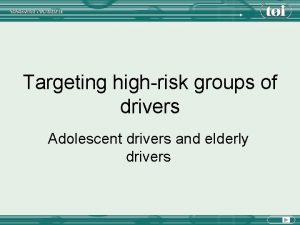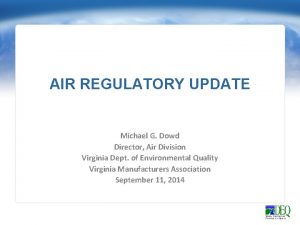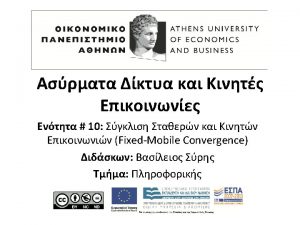NOx Understanding NOx and Air Regulatory Drivers for


























- Slides: 26

NOx Understanding NOx and Air Regulatory Drivers for NOx Control March 6, 2014 Raymond R. Allen, PE Evergreen Environmental Consulting LLC 9633 Octavia Ave. – Baton Rouge, LA 70809 Office: 225 -778 -5813 – Cell: 225 -590 -0491 raymond. allen@evergreenenvironmentalconsulting. com www. evergreenenvironmentalconsulting. com

New “ 100 ppb” 1 -hr NO 2 NAAQS �It’s a NO 2 standard and not a NOx standard! � Final rule for the new 1 -hour NO 2 National Ambient Air Quality Standard (NAAQS) in February 9, 2010 Federal Register – Effective April 12, 2010 � The 1 -hr NO 2 NAAQS is attained at a given receptor location when the 3 th-percentile of the annual distribution of daily year average of the 98 Explained in Slide 7 maximum 1 -hour NO 2 concentrations does not exceed 100 ppb � Industry legally challenged this new standard, but the U. S. Court of Appeal – DC Circuit upheld the new NO 2 1 -hr NAAQS in July 2012 � In January 2012 EPA designated all areas of the country as “unclassifiable/attainment” for the 2010 1 -hr NO 2 NAAQS. ? ? ? FYI: Even though data from EPA’s extensive national network of NO 2 ambient monitors indicate Attainment with the 1 -hr NO 2 NAAQS across the U. S. , some facilities that are now seeking NSR permits find it very difficult to demonstrate 1 -hr NO 2 NAAQS compliance due to EPA’s overlyconservative dispersion modeling guidelines and policies 2

History of the NO 2 NAAQS 39 Years! 1985 EPA Finding: No Changes to NO 2 NAAQS Warranted 1996 EPA Finding: No Changes to NO 2 NAAQS Warranted Source: Integrated Science Assessment for Oxides of Nitrogen – Health Criteria – First External Review Draft – 11 -2013 3

Design Value: 1 -hr NO 2 NAAQS NO/NO 2/NOx Monitor 2009 calendar year of 1 -hr NO 2 monitoring data Ambient-Air Monitoring Station 365 days The 1 -hr NO 2 NAAQS is attained at a given monitor location when the 3 -year average of the 98 th-percentile (8 th highest) of the annual distribution of daily maximum 1 -hour NO 2 concentrations does not exceed 100 ppbv 24 hr 24) =MAX(A 1. A High 1 365 daily max 1 -hr NO 2 concentrations sorted high to low 2 3 4 5 6 7 8 9 10 11 12 The 98 th percentile “cut point” for 365 data points ≥ 365 x (1 -0. 98) ≥ 7. 3 = 8 th highest value = 8 th highest daily maximum 1 -hr NO 2 concentration recorded during calendar year 2009 Ambient Monitor Design Value: A statistic that describes the air quality status of a given location (Attainment or Non. Attainment) with a NAAQS 4 Low A similar exercise was performed with 2010 and 2011 1 -hr NO 2 data. The three 8 th highest dailymaximum 1 -hr NO 2 results for 2009 -2011 are averaged: 2009 8 th HDM: 98 ppb 2010 8 th HDM: 102 ppb 2011 8 th HDM: 97 ppb NO 2 Design Value = 99 ppbv 1 -hr NO 2 NAAQS Attainment

New 1 -hr NO 2 NAAQS Challenges � Air Permitting Perspective: Demonstrating compliance with the NO 2 1 -hr NAAQS has proven to be an extreme challenge EPA’s 1 -hr ion for air dispersion modelers, and as a result some major plant NO 2 Dispers s ie c li o Modeling P expansions may have to rely on retrofit NOx control projects in order to legitimately “net out” of NSR review for NOx � EPA Modeling Guidance Still Overly-Conservative: “Additional Clarification Regarding Application of [40 CFR 51] Appendix W Modeling Guidance for the 1 -hour NO 2 National Ambient Air Quality Standard” issued March 1, 2011 and a prior memo dated June 29, 2010 – some key issues: NO NO 2 � Handling the conversion of NO to NO 2 in the ambient air � Establishing a realistic 1 -hr background NO 2 concentration for use in air quality demonstrations involving dispersion modeling HEADS UP: The 1 -hr NO 2 NAAQS is not the only new NOx-based challenge to NSR permitting - NSR rules now link both Ozone and PM-2. 5 ambient air standards with NOx emission increases 5

NOx Regulatory Definitions � SIP Definition from 40 CFR 51. 50: “Nitrogen Oxides (NOx) means nitrogen oxides as defined in 40 CFR 60. 2 and all oxides of nitrogen except N 2 O [nitrous oxide]. Nitrogen oxides should be reported on an equivalent molecular weight basis as nitrogen dioxide (NO 2)” [NO 2 Molecular Weight = 46. 0] � NSPS Definition from 40 CFR 60. 2: “Nitrogen oxides means all oxides of nitrogen except nitrous oxide, as measured by test methods set forth in this part” [Reference Method 7 series – 7, 7 A, 7 B, 7 C, 7 D, 7 E] CLARIFICATION: Most current-day NOx stack tests are conducted per Reference Method 7 E, an instrumental technique basically identical to a NOx/O 2 CEMS. Method 7 E is capable of providing the stack gas total NOx concentrations (ppmvd @ stack O 2 d) as well concentrations for NO and NO 2 individually – ensure your stack tester provides speciated NO and NO 2 test data because it may be needed for an NO 2 ambient-air compliance demonstration. Method 7 E reports NOx mass emissions “as NO 2”. All NOx mass emission calculations used for regulatory purposes should likewise assume all measured stack-gas NOx exists in the form of NO 2 (MW = 46. 0) 6

Key NOx Components: NO and NO 2 Nitric Oxide MW = 30. 01 The Greenhouse Gas Nitrous Oxide (N 2 O) is NOT NOx Nitrogen Dioxide MW = 46. 01 SIMPLIFYING ASSUMPTION: Most of our focus today is on current regulatory drivers to install NOx emission controls on new and existing industrial combustion processes. In this context, you can generally treat NOx as a simple two-components mix of NO and NO 2 7

Other NOx Components Potential PM-2. 5 Precursors Nitric Oxide MW = 30. 01 Nitrous Acid – HNO 2 Does the scientific evidence really support regulating secondary PM-2. 5 formed from NOx? Nitric Acid – HNO 3 Dinitrogen Trinitramide Trioxide – N 2 O 3 Tetroxide – N 2 O 4 Pentroxide – N 2 O 5 N(NO 2)3 REPEATING: Generally treat NOx as a simple two-component mixture of NO and NO 2 HOWEVER: As upcoming slides show, in the ambient air certain NOx constituents can potentially undergo reactions to form two other criteria pollutants: Ozone and PM-2. 5 8

Three Stages of NOx Chemistry Fuel Air COMBUSTION PROCESS NOx SNAPSHOT OF IN-STACK NOx POST-STACK NOx AMBIENT-AIR REACTIONS Combustion process NOx formation is addressed in our next presentation by Tom which focuses on NOx emission controls ISR: A helpful parameter in PSD modeling is the in -stack molar ratio of NO 2 to total NOx 1. NO to NO 2 Conversion N 2 + O 2 NOx = NO + NO 2 (ppmv) ISR = NOx (ppmv) NO NO 2 2. Ozone Formation NOx + VOC uv 3. PM-2. 5 Formation NOx + Other PM-2. 5 What happens in the Black Box? : NSR regulations now require us to consider the impact of NOx emissions on ambientair NO 2, Ozone & PM-2. 5 9 O 3

NO NO 2 Equilibrium in Ambient Air � Stack test data vary significantly, but as a rough rule of thumb, the NO 2 -to-NOx ISR is ~ 0. 1 (stack gas has 10% NO 2 and 90% NO) - EPA modeling guidance allows a conservatively-high default ISR of 0. 5 (50/50 spilt of NO/NO 2) � For emitted NOx EPA’s 1 -hr NO 2 modeling guidance assumes that when chemical equilibrium is achieved in the ambient air, the ratio of NO 2 -to-NOx is 0. 8 (emitted NOx ends up as 80% NO 2 and 20% NO in ambient air) � NO-to-NO 2 reaction goes both ways, but the ultimate outcome is a post-stack conversion of NO-to-NO 2 via several chemical reactions, including reactions that form ozone and PM-2. 5 pollution � EPA’s models are based on ozone reacting as a strong “NO scavenger” which converts NO to NO 2 – hence higher ozone levels increase the rate of NO-to-NO 2 conversion – is this always true? See slide after next 10

Black Box Model of NOx in the Ambient Air INPUTS Combustion stack-gas with NOx consisting mostly of NO with much less NO 2 (e. g. NO 2/NOx ISR ~ 0. 10 ) VOC & Other Emissions (e. g. CO, NH 3) Sunlight & Clear Skies (or not) Unfavorable Conditions? Black Box A Comp Witches lex ’ Brew? OUTPUTS Ambient Air NOx Pollution with mostly NO 2 and much less NO (e. g. NO 2/NOx Ratio ~ 0. 80 ) Ambient Air Ozone Pollution Ambient Air Secondary PM-2. 5 Pollution (nitrate-based) Reactions of VOC, NOx and other chemicals in the ambient air are highly-complex and very dependent on uncontrollable factors. In general, the presence of Unfavorable Conditions yields higher levels of all the NOx-related pollutants NO 2, O 3 and secondary PM-2. 5 FOUL CONDITIONS THAT EXASCERBATE NOx-DRIVEN POLLUTION FORMATION � Hot summer days, daylight hours, clear skies and high sunlight intensity � Low wind speeds & highly stable meteorology (e. g. Pasquill Stability Class F) � Presence of higher than normal short-term NOx and VOC emission levels � Presence of Highly Reactive VOC (HRVOC) emissions 11

NO NO 2 Reality Check Baton Rouge State Capital Site AAMS – June 2012 Data Averaged by Hour of the Day 0, 90 1 -hr avg ozone 0, 80 50 0, 70 40 0, 60 NO 2 -to-NOx Ratio 30 0, 50 0, 40 20 0, 30 1 -hr avg NO 2 10 0, 20 0, 10 0 Hour of the Day NO 2 –to-NOx Molar Ratio ppbv NO 2 or ppbv ozone 60 June 2012 Hourly Avg NO 2 (ppb) June 2012 Hourly Avg Ozone (ppbv) June 2012 Hourly Avg NO 2 -to-NOx Molar Ratio 0, 00 0000010002000300040005000600070008000900100011001200130014001500160017001800190020002100220023000000 Question: Does this slide show that ozone follows EPA’s stated model of reality by “scavenging NO” to increase both NO 2 levels and the NO 2 -to-NOx ratio? 12

New Source Review (NSR) and NOx OPTION: If making a NO 2 NAAQS and/or PSD increment modeling demonstration becomes too problematic, consider installing retrofit NOx controls and “netting out” of NSR – the result is federal BACT and/ or LAER will not be required NSR Regulatory Drivers for New NOx Controls � NSR permitting is pollutant-specific (NOx, O 3, PM-2. 5, etc) � Prevention of Significant Deterioration (PSD) = NSR for NAAQS attainment pollutants – CAA Title I Part C Ø Air quality demonstration via dispersion modeling and ambient monitoring must show future project won’t cause exceedances of any NAAQS or PSD increment Ø Best Available Control Technology (BACT) required on project-affected emission units with actual annual emissions increase of the subject PSD pollutant – case-by-case review � Non-attainment New Source Review (NNSR) = NSR for NAAQS non-attainment pollutants – CAA Title I Part D Ø Emission offsets of at ratio > 1: 1 required for NSR pollutant – offset ratio depends on the NA pollutant and the NA area classification Ø Lowest Achievable Emission Rate (LAER) technology required on project-affected emission units with actual annual emissions increase of NNSR pollutant – most stringent available 13

NSR Applicability Triggers Involving NOx Wow! Notes 1. No NO 2 non-attainment areas exist in the U. S. Shown here are requirements if such an area is ever designated by EPA. 2. No SIL exists for O 3. A more in-depth air study is typically required if a VOC or NOx emission increases exceed 100 tpy. 3. PM-2. 5 SILs from 40 CFR 51. 165(b)(2). January 2013 Court ruling vacated and remanded other PM-2. 5 SILs and SMC, (was set at 4 μg/m 3). Vacated regulations are 40 CFR 51. 166(k)(2) & (i)(5)(i)(c) and 52. 21(k)(2) & (i)(5)(i)(c). 4. Offset ratio shown for direct PM-2. 5. Preamble to the 2008 PM-2. 5 Rule identified inter-pollutant offset ratios for direct PM-2. 5 to NOx: Eastern US: 200 ton NOx to 1 ton direct PM-2. 5; Western US: 100 ton NOx to 1 ton direct PM-2. 5 14

NOx Control Driver: NSPS – CAA§ 111 �Federal New Source Performance Standards (NSPS) codified at 40 CFR Part 60 require technology-based emission controls for certain categories of industrial facilities when the facilities are either new, modified or reconstructed after a specified effective date �NSPS Subpart Ja – Petroleum Refinery Heaters – Post May 14, 2007 (Court-Ordered Stay on Much of NSPS Ja Lifted November 13, 2012) Ø Natural Draft Process Heaters Rated to Fire > 40 MMBtu/hr HHV-basis o o Either Or 40 ppmvd NOx @ 0% O 2 – 30 -day rolling average 0. 040 lb NOx/MMBtu HHV-basis – 30 -day rolling average Ø Forced Draft Process Heaters Rated to Fire > 40 MMBtu/hr HHV-basis o o Either Or 60 ppmvd NOx @ 0% O 2 – 30 -day rolling average 0. 060 lb NOx/MMBtu HHV-basis – 30 -day rolling average Are the alternative NSPS Ja Process Heater NOx limits equivalent? See the next slide 15

40 ppmvd NOx @ 0% O 2 = 0. 04 lb NOx/MMBtu? The two compliance options for the NSPS Ja Process Heater NOx limits are shown to be basically equivalent 16

NOx Control Driver: NSPS – CAA§ 111 � NSPS Subpart KKKK – Stationary Combustion Turbines Post February 18, 2005 � Proposed Revision to NSPS Subpart KKKK in August 29, 2012 Federal Register Partial List of Current NSPS Subpart KKKK Combustion Turbine NOx Emission Standards Large GT > 250 MWe Proposed NSPS KKKK has no changes to existing NOx limits, but does propose compliance with all NOx limits during startups, shutdowns and malfunction • NOTE: EPA is NOT claiming that the NSPS 4 K optional NOx concentration-based limits and the useful-power-output limits are equivalent – instead, the power output option rewards facilities with a high level of thermal efficiency • QUESTION: In the case highlighted above, what thermal efficiency “cutoff” dictates whether it’s best to go with the 4 K power-output-based NOx emission limit? See next slide 17

Selecting the Best GT NOx Limit Option FYI – A PSD BACT level for Greenhouse Gas (GHG) emissions for a utility combustion turbine in Louisiana was recently set at a heat rate of 7, 630 Btu/k. W-hr (or thermal efficiency of 44. 7%) 18

NOx Control Driver: Other NSPS �NSPS Subparts D, Da, Db & Dc – Boilers of all types and IGCC Units Ø Useful power output-based NOx limits added (June 13, 2007 Federal Register) �NSPS Subpart JJJJ – Spark-Ignition IC Engines (gasoline or gaseous fuel) Ø Rule modified multiple times – last revision in the June 28, 2011 Federal Register Ø Rule is complex and confusing – EPA website has requirements summary spreadsheet �NSPS Subpart IIII – Compression-Ignition IC Engines (diesel fuel) Ø Rule modified multiple times – last revision in the June 28, 2011 Federal Register Ø Rule is complex and confusing – EPA website has requirements summary spreadsheet �NSPS Rules Not Covered Today: Many other NSPS rules exist covering combustion equipment not directly addressed in this presentation, including dryers, calciners and multiple types of incinerators 19

NOx Control Driver: Ozone NA SIPs – NOx RACT �CAA Section 110 requires States to develop and implement State Implementation Plan (SIP) rules to bring NAAQS non-attainment areas into attainment – these SIP rules implement Reasonably Available Control Technology (RACT) �From a NOx perspective the only NAAQS pollutant currently of concern is Ozone, given that there are no NO 2 non-attainment areas designated in the U. S. , and it is not expected EPA would use a NOx emission reduction strategy to address PM-2. 5 non-attainment areas �NOx RACT may be a fairly simple set of NOx emission standards, such as the Louisiana NOx RACT standards shown on the next slide �In more difficult Ozone non-attainment areas, such as Houston, NOx RACT has evolved into a stringent NOx cap-and-trade program & 20

Example: Louisiana NOx RACT Rules NOTE 1: RACT rules generally adhere to technology-based emission limits developed by EPA. The NOx RACT limits shown here, from LAC 33: III. Chapter 22, have been implemented in the BR O 3 NA area. The BR area has recently been designated as an attainment area for the 8 -hr ozone NAAQS. All RACT rules remain in place after an area achieves attainment because of the CAA’s anti-backsliding provisions NOTE 2: Louisiana’s NOx RACT limits apply only during the ozone season (May 1 st to September 30 th) 21 NOTE 3: Louisiana’s NOx RACT rule has averaging plan provisions that allow for overcontrol of certain sources, while other sources remain uncontrolled – a “bubble” concept

NOx Control Driver: CSAPR � Cross-State Air Pollution Rule (CSAPR) replaces EPA’s 2005 Clean Air Interstate Rule (CAIR), which was vacated by U. S. Court of Appeals – DC Circuit in 2012 – the U. S. Supreme Court agreed to hear this case in June 2013 and EPA’s opening merits brief filed in September 2013 (www. epa. gov/crossstaterule ) � CSAPR imposes SO 2 and NOx cap-and-trade programs on power plants located in the eastern U. S. and establishes new C&T allowances – the allocation of allowances amongst affected States and individual utility units is a big issue! � EPA developed CAIR/CSAPR under the “good neighbor” provisions of the CAA to reduce ozone and PM-2. 5 pollution in downwind non-attainment areas NOTE : There are three different types of emission allowances under the CSAPR capand-trade program 22

Map of CSAPR-Affected U. S. States NOTE : All U. S. States fall into 1 of 4 possible categories of requirements under CSAPR’s cap-and-trade program Climate Change is Real Folks! 1. Submit CSAPR caption ideas to raymond. allen@evergreenenvironmentalconsulting. com 23

Final NOx Control Driver: Consent Decree As the petroleum refining industry is already keenly aware, regulators are using the Consent Decree process to extract emission reductions and impose other requirements on industry. The following definitions from a refinery CD are typical of NOx controls required: � “Current Generation Ultra-Low NO Burners shall mean the Current Generation Ultra-Low NOx Burners that are designed to achieve a NOx emission rate of 0. 020 to 0. 040 lb/MMBtu HHV when firing natural gas at 3% stack oxygen at full design load without air preheat, even if upon installation actual emissions exceed 0. 040 lb/MMBtu HHV” � “Next Generation Ultra-Low NO Burners or Next Generation ULNBs shall mean those burners that are designed to achieve a NOx emission rate of less than or equal to 0. 020 lb/MM Btu HHV when firing natural gas at 3% stack oxygen at full design load without air preheat, regardless of whether upon installation actual emissions exceed 0. 020 lb/MM Btu HHV” � “Qualifying Controls for the purposes of NOx control technology for heaters and boilers, shall mean: SCR or SNCR; Current Generation or Next Generation Ultra-Low NO Burners; or other technologies or combination of technologies which COMPANY X demonstrates, to EPA’s satisfaction, will reduce NOx emissions to 0. 040 lbs. per MMBtu or lower. NOx control technology may include the permanent shutdown of a heater or boiler with revocation of its federally enforceable operating and construction permits” 24

Take-Aways & Closing Remarks NOx � EPA revoked the 1 -hr O 3 NAAQS in favor of an 8 -hr O 3 NAAQS after many years of deliberation, primarily because of the complexity of inter-pollutant reactions in the ambient air – we are now faced with a similar quandary with the new 1 -hr NO 2 NAAQS – did EPA fail to learn a lesson from the previous problems we experienced while implementing the 1 -hr ozone NAAQS? � The federal NSR rules make the presumption that PM-2. 5 formation from NOx precursors is significant enough to require PSD review for PM-2. 5 with only a 40 ton/yr NOx emissions increase – is this approach based on sound science? � As a result of EPA’s overly-conservative NO 2 dispersion modeling policies, it is difficult to make NO 2 ambient-air compliance demonstrations – because of this and other NSR permitting obstacles associated with NOx, some facilities are choosing to legitimately avoid NOx NSR permitting altogether by installing retrofit NOx controls and “netting out” of the NSR permitting process 25

Take-Aways & Closing Remarks NOx � A skilled air permitting and compliance engineer should be fully capable of: Ø Comparing alternative NOx emission limits on an “apples-to-apples” basis Ø Characterizing and quantifying a combustion unit’s thermal efficiency, if necessary Ø Characterizing and quantifying NOx emissions performance during periods of start- up, shut down, and malfunction � The Heater & Boiler MACT rules (40 CFR 63 Subparts 5 D & 6 J) were not covered today because they do not contain specific NOx emission limits – one admonition, however, is that when conducting heater or boiler tune-ups under these rules, ensure nothing is changed that will negatively impact the NOx performance of any LNBs, ULNBs or any other inherent or add-on NOx controls � CONCLUSION: There are numerous regulatory drivers that will require the installation of NOx controls on new and existing combustion units over the next several years – make sure the best NOx control technology is selected by gaining a firm understanding of how NOx control technologies work 26
 Driver education signs
Driver education signs Air higroskopis air kapiler dan air gravitasi
Air higroskopis air kapiler dan air gravitasi Nox controller
Nox controller Understanding air pressure
Understanding air pressure Understanding air permits
Understanding air permits Chapter 22 regulatory and advisory agencies
Chapter 22 regulatory and advisory agencies Dea number verification
Dea number verification Diversity and regulatory challenges
Diversity and regulatory challenges Warehousing development and regulatory authority
Warehousing development and regulatory authority Pharmaceutical regulatory and compliance congress
Pharmaceutical regulatory and compliance congress Department of licensing and regulatory affairs
Department of licensing and regulatory affairs Legal regulatory and political issues
Legal regulatory and political issues Pharmaceutical regulatory and compliance congress
Pharmaceutical regulatory and compliance congress Legal and regulatory framework of microfinance in india
Legal and regulatory framework of microfinance in india Pharmaceutical regulatory and compliance congress
Pharmaceutical regulatory and compliance congress Pharmaceutical regulatory and compliance congress
Pharmaceutical regulatory and compliance congress Nox do oxigenio
Nox do oxigenio Nox do h
Nox do h Nox network
Nox network Sources of nox emissions
Sources of nox emissions Nox adgangskontrol
Nox adgangskontrol Cl nox
Cl nox Nox do carbono
Nox do carbono Otcova rola rozbor
Otcova rola rozbor Tabela de nox fixos
Tabela de nox fixos Nox
Nox Mg nox
Mg nox


